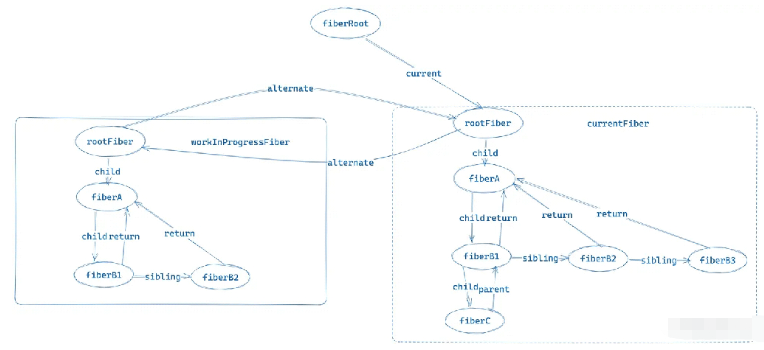您好,登錄后才能下訂單哦!
您好,登錄后才能下訂單哦!
這篇文章主要介紹了React怎么更新流程驅動的相關知識,內容詳細易懂,操作簡單快捷,具有一定借鑒價值,相信大家閱讀完這篇React怎么更新流程驅動文章都會有所收獲,下面我們一起來看看吧。
首先我們書寫的函數式組件、類組件、jsx等代碼全部會被babel-react編譯成react.createElement()的調用或者jsx()調用(取決于react版本)。
舉個栗子:
<div> <ul> <li key='1'>1</li> <li key='2'>2</li> <li key='3'>3</li> </ul> </div>
轉換成
React.createElement(
'div',
null,
React.createElement(
'ul',
null,
React.createElement(
'li',
{
key: '1'
},
'1'
),
React.createElement(
'li',
{
key: '2'
},
'2'
),
React.createElement(
'li',
{
key: '3'
},
'3'
)
)
);接下來我們需要知道React.createElement內部到底做了什么?源碼位置
內部的實現其實很簡單,就是處理傳入的type/config/children等參數,再返回一個新的對象。
從config中分離出特殊屬性 key 和 ref
將普通屬性以及children添加到props中
最后返回一個對象,這個對象我們稱之為ReactElement元素
ReactElement數據結構如下:
const element = {
$$typeof: REACT_ELEMENT_TYPE,
type,
key,
ref,
props,
};'$$typeof':ReactElement的標識
'type':可能是'div' 'span'這樣的字符串標簽,也可以是個函數(函數式組件)、類(類組件)
'key/ref/props': ReactElement的屬性
所以上述栗子的調用結果是下面的樹形結構:
{
type: 'div',
key: null,
ref: null,
props: {
children: {
type: 'ul',
key: null,
ref: null,
props: {
children: [
{
type: 'li',
key: null,
ref: null,
props: {
children: '1'
}
},
{
type: 'li',
key: null,
ref: null,
props: {
children: '2'
}
},
{
type: 'li',
key: null,
ref: null,
props: {
children: '3'
}
}
]
}
}
}
}到這里就已經完成第一個和第二個小目標。
不過在這里要多提一下,上述的樹形結構,在react15版本及以前就可以直接拿來diff以及生成頁面,不過正如第一篇文章所說,這樣會遇到很大的問題(任務過重js執行時間久,影響渲染)。
所以16之后做的事情,就是依據上述的樹形結構進行重構,重構出來的fiber數據結構用于滿足異步渲染之需。
上篇文章中已經介紹了fiber節點的數據結構,這里我們再介紹下fiberRoot以及rootFiber。 fiberRoot源碼位置
FiberRoot數據結構:
class FiberRootNode {
current: FiberNode;
container: any | null;
finishedWork: FiberNode | null;
pendingLanes: Lanes;
finishedLane: Lane;
pendingPassiveEffects: PendingPassiveEffects;
constructor(container: any | null, hostRootFiber: FiberNode) {
this.current = hostRootFiber;
this.container = container;
hostRootFiber.stateNode = this;
this.finishedWork = null;
this.pendingLanes = NoLanes;
this.finishedLane = NoLane;
this.pendingPassiveEffects = {
unmount: [],
update: []
};
}
}其中很多屬性我們暫時無視,后續涉及到的時候會詳細講解,這里重點關注節點的關系。 rootFiber的數據結構和普通的FiberNode節點區別不大,這里不再贅述~
整個React應用有且只有一個fiberRoot
整個應用中同時存在兩棵rootFiber樹
當前頁面對應的稱為currentFiber,另外一顆在內存中構建的稱為workInProgressFiber,它們通過alternate屬性連接。
fiberRoot中的current指針指向了currentFiber樹。
當整個應用更新完成,fiberRoot會修改current指針指向內存中構建好的workInProgressFiber。
圖形描述如下:

在mount階段的時候,應用是需要一個執行函數的,而這個函數就是(源碼位置)
react.createRoot(root).render(<App/>)
root: 模版文件中的id為root的div
<App>: 整個應用的根組件
源碼簡化后的代碼如下:
const createRoot = (container: Container) => {
const root = createContainer(container);
return {
render(element: ReactElementType) {
return updateContainer(element, root);
}
};
};createRoot會返回一個對象,其中包含了render函數,我們具體看看createContainer做了哪些事情。
const createContainer = (container: Container) => {
// 創建rootFiber
const hostRootFiber = new FiberNode(HostRoot, {}, null);
// 創建fiberRoot
const root = new FiberRootNode(container, hostRootFiber);
hostRootFiber.updateQueue = createUpdateQueue();
return root;
};react.createRoot()在內部會去創建整個應用唯一的fiberRoot和rootFiber,并進行關聯。(如上述圖形結構)
render內部執行的是updateContainer(),我們查看下內部實現:
const updateContainer = (
element: ReactElementType,
root: FiberRootNode
) => {
// mount時
const hostRootFiber = root.current;
// 添加update任務
const lane = requestUpdateLane();
const update = createUpdate<ReactElementType | null>(element, lane);
enqueueUpdate(
hostRootFiber?.updateQueue as UpdateQueue<ReactElementType | null>,
update
);
scheduleUpdateOnFiber(hostRootFiber, lane);
return element;
};其中有很多地方我們此時無須關心,但是我們看到內部調用了scheduleUpdateOnFiber, 而這個就是更新流程(schedule(調度)->reconciler(協調)->commit (渲染))的入口。
而這個入口不僅僅在初始化執行函數中render調用會喚起,還有其他的方式:
類組件中setState -> scheduleUpdateOnFiber()
函數組件useState -> scheduleUpdateOnFiber()
關于“React怎么更新流程驅動”這篇文章的內容就介紹到這里,感謝各位的閱讀!相信大家對“React怎么更新流程驅動”知識都有一定的了解,大家如果還想學習更多知識,歡迎關注億速云行業資訊頻道。
免責聲明:本站發布的內容(圖片、視頻和文字)以原創、轉載和分享為主,文章觀點不代表本網站立場,如果涉及侵權請聯系站長郵箱:is@yisu.com進行舉報,并提供相關證據,一經查實,將立刻刪除涉嫌侵權內容。